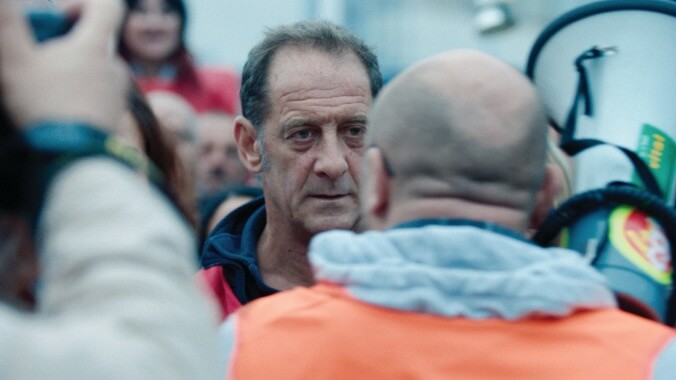For better and worse, At War captures the exhausting struggle of a labor dispute

A fictional but all-too-believable in-the-trenches look at an industrial labor dispute, At War opens with news footage that lays out the situation plainly. The German group Dimke have announced the closure of an auto-parts factory in southwestern France. This, after the company’s roughly 1,100 workers completed two years of additional work for no extra pay and management broke their commitment to guaranteeing five more years of full factory operation. The “non-competitiveness” of the industry is put forward as an explanation, but the CEO’s multi-million dollar salary (not to mention a 25% increase in shareholder dividends) would seem to belie that statement. After relaying the basic facts, the film cuts right into the action, with union leader and factory worker Laurent Amédéo (Vincent Lindon) fronting tense negotiations with the intransigent, indifferent management. There’s no ambiguity here. The injustice of the situation is unequivocal—and the odds are stacked against the workers.
Director Stéphane Brizé previously teamed with Lindon on The Measure Of A Man, a 2016 Cannes-winner that was likewise firmly aligned with the working class, following a middle-aged man as he goes from unemployed machinist to reluctant department store security guard. (That film’s original French title, La Loi Du Marché, translates as The Law Of The Market, which could well be used here.) Although it focuses on a collective rather than an individual, At War is, in some ways, less complex, though not necessarily less compelling. Playing a charismatic, fiery spokesperson, Lindon is again the clear focal point of the film, but Brizé and his co-screenwriter, Olivier Gorce, prefer not to freight his character with excessive backstory. There are brief glimpses into Laurent’s private life—we learn that he’s about to become a grandfather—but the film’s progression doesn’t conform to his character arc. Mostly, At War moves among a set of fixed locations, observing the workers’ fruitless negotiations with company management, their circuitous in-group disputes, and their violent clashes with riot police (set to Bertrand Blessing’s nerve-jangling score).
Practically, this means that most of At War consists of French people loudly shouting at each other, which makes for an impassioned if also exhausting experience at close to two hours. The salient developments of the ongoing dispute—the decision to strike, a court ruling that sided with management against the factory’s closing—are clearly laid out. But these details are secondary to the dominant experiential tenor of each scene; Brizé’s stolid direction alternately conveys anger, fatigue, indignation, frustration, and even (short-lived) relief. More even than emotional impact, what the French director is after is capturing the physical sensation of the workers’ experience: what it might feel like to be trapped in a room arguing fruitlessly against a bunch of suits, or facing off against armed police in a building lobby.
In its justified anger and agitprop vigor, At War brings to mind Mike Leigh’s recent Peterloo, which, despite its distinct period and milieu, shares Brizé’s concern with class struggle. But whereas Leigh’s film was defined by the director’s talents for exaggerated behavior and memorable characterization, Brizé’s favors vérité-style camera movements (courtesy of cinematographer Éric Dumont) and naturalistic acting (from a cast of actual factory workers). Although successful on its own terms, this approach eventually constrains the resonance. Ultimately, At War isn’t able to offer much more than gradual escalation of intensity. Even before the war is over, it’s hard not to withdraw.